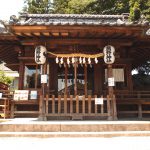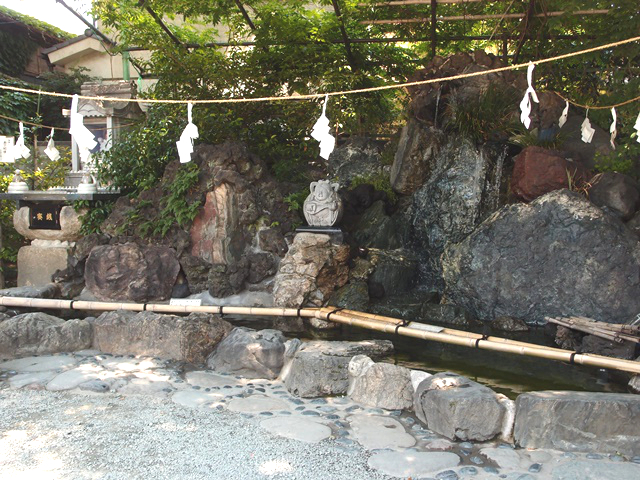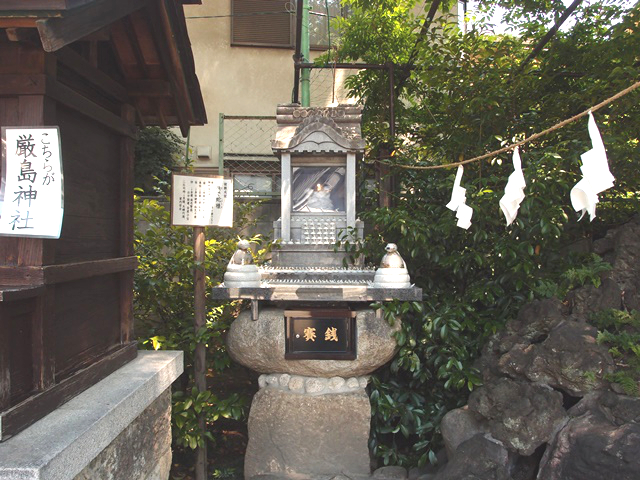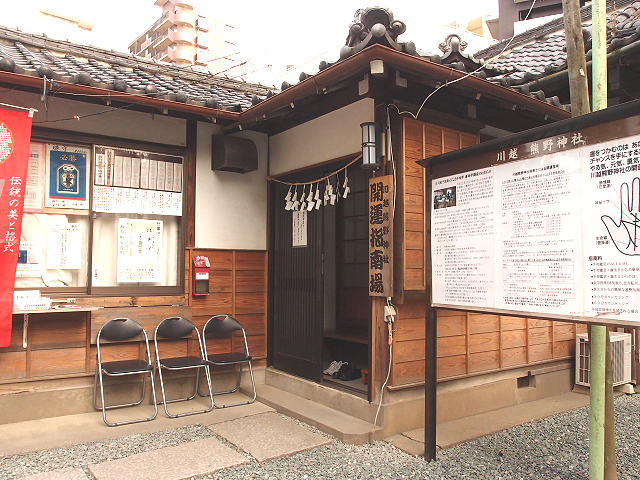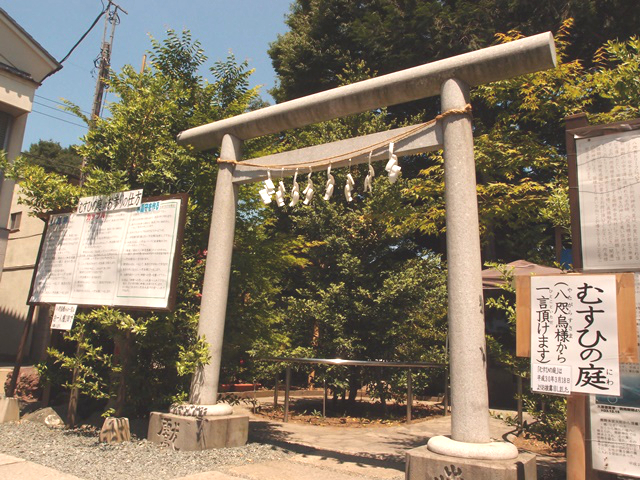Though Kawagoe is famous for its "Kawagoe Hikawa-jinja Shrine", the “Kawagoe Kumano-jinja Shrine" which is located along the Taisho Romanyume-dori street, is also popular among tourists.
Japanese
-

-
川越熊野神社は注目スポットいっぱい!100%楽しむためのポイント
続きを見る
目次
About the Kawagoe Kumano-jinja
The Kumano-jinja Shrine is a shrine located near the entrance of the Taisho Romanyume-dori Street.
Enshrined deities and divine blessings
The Kumano-jinja Shrine is a shrine that brings blessings of love and marriage.
The following three deities are enshrined here.
- 伊弉諾尊(Izanami-no-Mikoto)
- 事解之男命(Kotosakanoo-no-Mikoto)
- 速玉之男命(Hayatamanoo-no-Mikoto)
As Izanami-no-Mikoto and Kotosakanoo-no-Mikoto not only created the path of couple hood but also gave birth to all things in nature, they are known as gods of love and marriage.
It was originally the same as the Renkeiji Temple
The Kumano Shrine is said to have begun in 1590 (the 18th year of the Tensho era) when the high priest Nenyoubunou II performed the ceremonial transfer of the shrine from Kumano in Kishuu (present day Wakayama Prefecture).
It was once a part of the Renkeiji temple but became an independent shrine during the separation of Shintoism and Buddhism in 1868 (the 2nd year of the Meiji era).
↓Click below for information regarding the Renkeiji Temple.
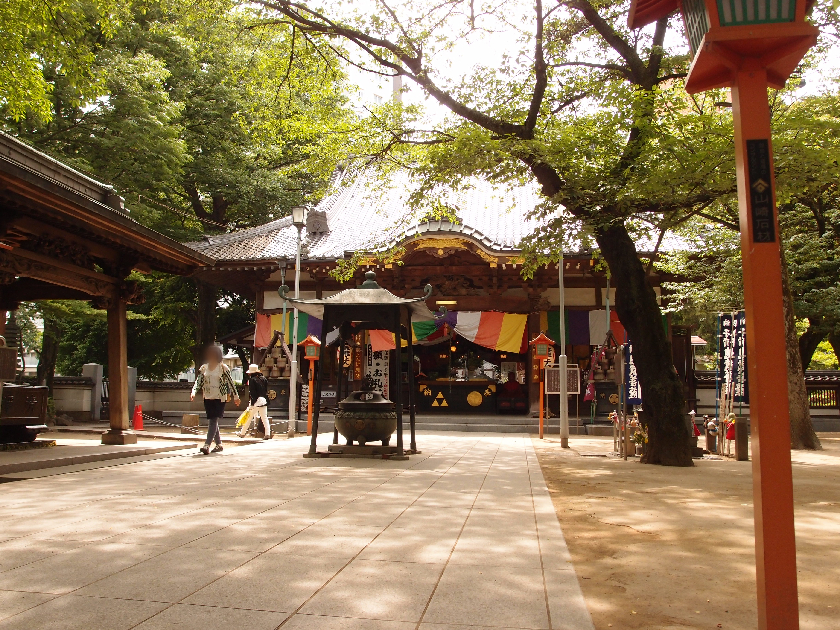
諸願成就 おびんずる様の蓮馨寺 境内には焼きそば・だんごの売店も
The Torinoichi festival is also held here in winter
On the grounds of the Kumano-jinja Shrine, stands the Saginomiya-jinja sub-shrine.Because of this, the "Torinoichi Festival" is held on December 3rd of every year for the prosperity of the city.Many visitors gather at this event to purchase Kumate (lit. bear hand) lucky charms for good luck.
↓Click here to see the Torinoichi festival

川越熊野神社の酉の市 熊手の粋な買い方をマスターしてゲン担ぎ!
Walking around the grounds of the Kumano-jinja Shrine
The grounds of Kumano-jinja Shrine are similar to a small theme park.
A famous attraction! Stimulating the pressure points of your feet by walking on the “Kenkou Path” (Health road).
When it comes to the Kumano-jinja Shrine, it’s definitely the Kenkou Path.It’s just passed the torii gate.
This pebble pathway was built in 2004 from the viewpoint that “Health is No 1 no matter what”.Walking here won’t bring you any good luck in particular, but your blood circulation will improve from the stimulation of the pressure points of your feet!

Wearing shoes on this path is prohibited so make sure to take them off.

Depending on the person, different pressure points hurt more than others, I personally don’t do well with the small white stones...

Logs that you can take a small break on.This was the most soothing place to stand on but some people also say that“standing on them is the most painful".
The god Inari’s fortune ring toss
There is a ring toss on the grounds that you can play to try your luck at winning good fortune, but before you play you must first visit the Kayu-Inari-jinja shrine shown in the photo and make an offering of 10 yen or more.
The Kayu-Inari-jinja Shrine
The god Inari is commonly known as "Kasuke-sama" or "Oinari-sama".Oinari-sama is the god who protects the ripening of the rice harvest and helps people with good luck in “ripening” or “harvesting” their wishes.
Although the history of the shrine is no longer known, it is said that to have been here before the Renkeiji Temple was built.
Fortune ring toss
Once you’ve made an offering, challenge yourself with a ring toss!
There are five fortunes to throw for, luck with love, luck with work and school, luck with health, luck with money, and luck with having your prayers answered.

From the wa-okiba (place where rings are stored), take out three rings only, and stand in front of the fortune board to try your luck.
Purify your money at the Takaraike Pond (Treasure Pond) (Zeniarai Benzaiten)
In June 2017 (the 19th year of the Heisei era), the Takaraike Pond was built to match the annual festival of the Tsukushima-jinja Shrine and the Zeniarai (coin washing) Benzaiten (the Buddhist goddess of Indian origin Sarasvati, known in Japanese as Benzaiten).
It is said that there was a pond called the Takaraike Pond at the Renkeiji-jinja Shrine (proper name: “Kohouzan Houchiin Renkeiji”) which was once a part of the Kumano-jinja Shrine
※Houchi (宝池-the kanji can also be read as Takaraike)
The water of the Takaraike pond is drawn from the same source as that of the Takaraike Pond of the Kumano-Jinja Shrine from before.
Visiting the Zeniarai Benzaiten
First, visit the Itsukushima-jinja shrine next door.Some people throw coins in the pond, but this is not allowed.Please properly put your coins into the offertory box.

After you finish your visit, pick up a sieve from the shelf and put coins in it.The 2 ways to purify your money.
- Washing it by putting the sieve in the Takaraike Pond.
- Washing it by placing the sieve on the bamboo rods and scooping holy water onto them with a ladle.
Please spend the purified money right away.Though you may want to keep it hidden away in your wallet as a lucky charm, using it proactively is the correct thing to do.
Although there are various opinions, it is said that through the economy, this money will circulate and come back to you again.
On holidays many people visit the Shrine, so there are times when there is a line.
The front shrine of the Kumano-jinja Shrine.There are times when there is a line here in the afternoon on holidays.
“Nade Hebi Sama” Petting the great snakes for Shogan-Jyoujuu (having your prayers answered)
It is said that the statues of the white snake next to the Takaraike Pond provides you with blessings if you make a wish while petting them in various places.
- Head: Academic achievement, Successful passing of exams.
- Scroll: Progression of accomplishments, Wisdom
- Body: Physical Health, Recovery from illness
- Eggs: Luck with Money, prosperity in business, career advancement, safe childbirth and blessed children
When you stroke both snakes at the same time, you will be blessed with good relationships, marriage and peace and prosperity in your household.
Get a palm reading at the Kaiun-Shinan-ba
On the grounds of the shrine is the “Kaiun-Shinan-ba” where you can have your palm read using astrology and fortune telling based on the Chinese 12 year cycle for marriage and love, health concerns, work (suitable occupations), luck with money, happiness, etc.
The courses range from a 10 minute palm reading to an in-depth 60 minute palm reading, so please give it a try if it interests you.
Those that use fire on a daily basis should visit the Akiba-jinja shrine
The god Hinokagutsuchi-no-Mikoto, the god of fire prevention and firefighting is enshrined here.It is said to be highly admired by chefs, firefighters, housewives and other people who use fire on a daily basis.

It is located just next to the front shrine of the Kumano-jinja Shrine, but it may be hard to find because it is situated a bit deeper into the grounds.
Receive guidance from the god Yatagarasu at the Musuhino-niwa Garden.
Here you can receive guidance from the god Yatagarasu. It is located just next to the main shrine.
Why Yatagarasu?
"Yatagarasu" is a three-legged crow who also appears in the logo of the Japan Football Association.
The Kumano Miyama (the national headquarters of the Kumano Shrine) believes that Yatagarasu is the bird that served the god Kumano Oogami.
Also, in Japanese mythology, it is said that the legendary founding emperor of Japan, Emperor Jinmu, was guided from Kumano to what was formerly Yamato Province (present day Nara Prefecture) by Yatagarasu, who is also worshiped as "the god of guidance".
The kanji “咫” in “八咫烏” (Yatagarasu) is pronounced “ata” and is a word for a unit of length.It corresponds to the length from the thumb to the middle finger of a stretched out hand, about 18 cm.And since “八” (ya) means 8 in Japanese, “八咫” (yata) becomes 18 cm × 8 = 144 cm, but it is not known if Yatagarasu was really that size.
At any rate, it may mean that the bird was about that size.
How to visiting the Musuhino-niwa garden
The rules for visiting are as follows.
- Wait in front of the torii gate until the person in front of you has finished bowing.
- When the previous person heads to the torii gate, bow and enter the torii gate.
- The walking route is set.

When visiting as a couple, men should walk around on the right side and women should walk around on the left side. When couples meet eye to eye at the other end, the man must always be the first to speak. (For example: Man: ”Oh, how beautiful you are”, women “Oh, how handsome you are”).
There is no set rule for walking in the clockwise or counterclockwise direction for individuals, families, or friends who visit the shrine, so please enter from whichever end you like. - Once you arrive in front of Yatagarasu, begin by visiting (praying to) the shrine.

- After that, the couple should reach their hands out together and touch the glass orbs of marriage. People other than couples should pick one out of three balls and touch them gently in contemplation.

- Yatagarasu will provide you with guidance. (His voice is pretty loud....)
- After receiving his guidance, bow once and walk towards the Torii gate
Why does the man speak first?
For visiting couples, the reason the man must speak first is believed to have been derived from Japan’s older historical records.
The famous gods Izanagi and Izanami, are famous for having achieved the creation of the earth.
If fact, these two Gods failed once at having children.This was because Izanami, a woman, spoke first.
After that, it is said that when Izanagi, a man, spoke first, their first child (The country of Japan) was born without issue.
Motonomokuami’s Kahi (a monument engraved with a Tanka)
A Tanka (Japanese poem) written by Motonomokuami (Japanese poet) is engraved here.
山ざくら咲けば白雲 散れば雪
花見てくらす 春ぞすくなき< When the mountain cherry blossoms bloom,
and snow falls from white clouds.
Live among the flowers,
spring is short >
It is said that Motonomokuami of Saitama Prefecture, who was born in 1724 (the 9th year of Kyoho era), spent a period of time living in "Matsugo no Kubo" which was located in front of the Renkeiji Temple’s gate.
The above poem is said to have been written while gazing at the cherry blossom trees of the Renkeiji temple from a far.
The Cherry blossoms of the Renkeiji Temple.

An abundance of omikuji (fortune) varieties
The Kumano-jinja Shrine is also known for having a wide variety of omikuji (fortunes).
From orthodox 'omikuji' to 'marriage omikuji', omikuji specific to blood type that can be taken from separate boxes called 'blood type omikuji', 'magatama omikuji' (fortunes with comma shaped jewels) and 'sensu omikuji' (fortunes written on a fan), many unique types are available.
The collection of omikuji will make you want to take them all.
The cutely designed ema
Recently the number of shrines that design their own ema (literally translated as "picture-horse", ema are small wooden plaques that Shinto and Buddhist worshippers write prayers or wishes on) have increased. The Kumano-jinja Shrine also has a rich variety of ema.
There are 6 types of ema prayers or wishes.In addition to this, there are illustrated varieties such as an ema with a female manga character design that says "Nice to meet you, God".
As for the hanging display of sample ema, the Yatagarasu design ① and the heart shape ③ are relatively popular.
Dokan no Dashi
The Dokan no Dashi is a warehouse where one of the floats used in the Kawagoe Festival is stored.Essentially, it only opens during the Kawagoe Festival, but when events are held at the Kumano-jinja Shrine and neighboring shrines, the floats are sometimes displayed.
Access to the Kawagoe Kumano-jinja Shrine · Time required
On foot or by bus
A 6 minute walk from Seibu Shinjuku Line “Honkawagoe Station”.
An 18 minute walk from JR Tobu Tojo Line "Kawagoe Station".
From the JR Tobu Tojo Line "Kawagoe Station" (East Exit), take the Tobu Bus and get off at "Renkeiji mae". It is less than a minute’s walk from here. (About a 5 minute bus ride)
There is no parking lot
There is no dedicated car park at the Kumano-jinja Shrine.There is a parking lot just beside the shrine, but let’s avoid parking there as it is not affiliated with the shrine.
Click here for Times car parks near the area.
How much time does it take to visit the Kumano-jinja shrine?
It takes about 15 minutes.
As the site is not too big, and if you just come to visit the shrine (pray), you will be finished in about 3 minutes.
From the rear entrance of the Kumano-jinja shrine (at the side of the Dokan no Daishi), you can reach the Renkeiji Temple in 1 minute on foot, so please visit it as well.
-

-
諸願成就 おびんずる様の蓮馨寺 境内には焼きそば・だんごの売店も



